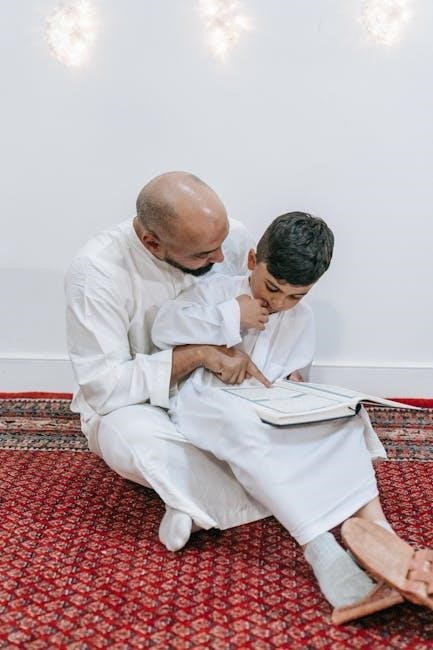Beowulf is an epic Old English poem exploring heroism, fate, and loyalty․ It recounts the adventures of a brave Geatish warrior battling monsters, reflecting Anglo-Saxon culture and values․
1․1 Background and Historical Context
Beowulf is set in Scandinavia during the 6th century, reflecting Anglo-Saxon culture and values․ The poem, written by an anonymous author, blends historical and mythical elements, exploring themes of heroism and fate․ It highlights the societal norms of the time, including loyalty to kings and the struggle between paganism and Christianity․ The story’s setting in Denmark and Geatland underscores its roots in Nordic folklore and the oral traditions of the era․
1․2 Importance of the Poem in English Literature
Beowulf is the oldest surviving English epic poem, offering insights into Anglo-Saxon culture and language․ It bridges paganism and Christianity, showcasing themes of heroism, loyalty, and fate․ The poem’s rich imagery and alliteration have influenced countless literary works, making it a cornerstone of English literature studies․
Its exploration of universal themes continues to resonate, inspiring modern adaptations and scholarly analysis․ Beowulf remains a vital text for understanding early English identity and literary traditions․

Plot Summary and Structure
Beowulf recounts the battles of a Geatish hero against monstrous foes․ The poem’s structure follows Beowulf’s journey from youth to kingship, emphasizing his bravery, loyalty, and ultimate sacrifice․
2․1 Key Events in the Poem
Grendel’s attack on Heorot initiates the conflict, while Beowulf’s arrival marks the hero’s entrance․ The battle with Grendel showcases his strength, and Grendel’s mother’s revenge deepens the conflict․ The final battle with the dragon concludes Beowulf’s journey, highlighting themes of heroism, sacrifice, and fate․ These events form the core of the narrative, driving the poem’s exploration of bravery, loyalty, and the inevitable passage of time․
2․2 The Three Battles: Grendel, Grendel’s Mother, and the Dragon
Grendel’s battle in Heorot highlights Beowulf’s physical strength, while the fight with Grendel’s mother in her lair adds emotional depth, showcasing his strategic prowess․ The dragon battle symbolizes the end of an era, reflecting themes of aging and sacrifice․ Each battle underscores Beowulf’s heroism, yet reveals the inevitability of fate․

Major Characters Analysis
Beowulf is the heroic protagonist, embodying courage and loyalty․ Grendel represents evil, while Hrothgar and Unferth highlight human complexity, shaping the poem’s moral and cultural landscape․
3․1 Beowulf: The Hero’s Journey
Beowulf embodies the classic hero’s journey, evolving from a young warrior to a wise leader․ His battles against Grendel, Grendel’s mother, and the dragon showcase his bravery and selflessness․ Initially driven by glory, he matures into a ruler prioritizing his people’s safety․ His journey reflects the Anglo-Saxon ideals of loyalty, honor, and the inevitability of fate, leaving a lasting legacy in literature and cultural heritage․
3․2 Grendel: The Antagonist and His Motivations
Grendel, a descendant of Cain, embodies evil and chaos․ His resentment toward the joy in Heorot drives his attacks, seeking to destroy the harmony of Hrothgar’s kingdom․ Grendel’s motivations stem from jealousy of human prosperity and a desire to disrupt order․ His actions symbolize the struggle between light and darkness, highlighting the poem’s themes of good vs․ evil and the fragility of human achievement in the face of monstrous forces․
3․3 Hrothgar, Unferth, and Other Key Figures
Hrothgar, the wise king of the Danes, rules with generosity and strength, building the majestic hall Heorot․ His leadership is tested by Grendel’s attacks, revealing his desperation for salvation․ Unferth, Hrothgar’s advisor, initially resents Beowulf but later admires his bravery․ Other figures like the narrator and the scop enrich the story, highlighting the cultural and historical depth of the poem through their perspectives and roles in preserving its legacy․

Themes and Motifs
Themes in Beowulf include heroism, loyalty, fate, and the struggle between good and evil․ Motifs like light vs․ darkness and the mead-hall symbolize civilization and human resilience․
4․1 Heroism and Bravery
Heroism in Beowulf is exemplified through the protagonist’s willingness to confront formidable foes․ His bravery is unwavering, from battling Grendel to facing the dragon, showcasing selflessness and honor․ The poem highlights how heroism is not just physical strength but also moral courage, as Beowulf risks his life for the greater good, embodying the Anglo-Saxon ideal of a hero who inspires others through his deeds․
4․2 Loyalty and Honor
Loyalty and honor are central themes in Beowulf, defining the warrior’s code of conduct․ Beowulf’s unwavering loyalty to his king, Hygelac, and his people, the Geats, drives his actions․ Similarly, his commitment to Hrothgar and the Danes reflects the importance of honor in Anglo-Saxon culture․ The poem underscores how loyalty binds individuals and societies, while honor is earned through deeds that uphold one’s reputation and the greater good, making it a cornerstone of heroic identity;
4․3 Fate and Destiny
Fate and destiny are central themes in Beowulf, reflecting the Anglo-Saxon belief in a predetermined course of life․ Characters often accept their fate, as seen in Beowulf’s final battle with the dragon, where he knowingly faces death․ The poem explores the tension between fate and individual choice, emphasizing that true heroism lies in embracing one’s destiny․ This theme underscores the inevitability of death and the enduring legacy of a life lived with courage and honor․

Symbolism in Beowulf
Beowulf is rich in symbolism, with Herot Hall representing civilization and community, while Grendel’s lair embodies darkness and chaos․ Light and darkness symbolize good versus evil, and the dragon represents destructive greed and ultimate doom․
5․1 Herot Hall as a Symbol of Civilization
Herot Hall symbolizes the heart of civilization and community in Beowulf․ This grand mead-hall, built by King Hrothgar, represents the unity and culture of the Danish people․ It serves as a gathering place for feasts, celebrations, and governance, embodying the values of prosperity and harmony․ The hall’s splendor contrasts sharply with the darkness of Grendel’s lair, highlighting the struggle between order and chaos․ Its destruction by Grendel underscores the fragility of human achievements․
5․2 Grendel’s Lair: Symbol of Darkness and Chaos
Grendel’s Lair embodies the essence of darkness and chaos, contrasting with the order of Herot Hall․ Described as a shadowy, eerie realm, it symbolizes the monstrous and the unknown․ The lair’s dark, mysterious nature reflects Grendel’s malevolent character and his hatred for the light and joy of human civilization․ It serves as a physical manifestation of evil, highlighting the poem’s central conflict between good and darkness, and the eternal struggle of humanity against forces of destruction․

Historical and Cultural Context
Beowulf is set in Scandinavia, reflecting Anglo-Saxon values like loyalty, bravery, and fate․ The poem blends history and mythology, offering insights into the culture of Denmark and Geatland․
6․1 Anglo-Saxon Culture and Values
Anglo-Saxon culture, reflected in Beowulf, emphasizes loyalty, bravery, and honor․ The poem highlights the importance of kinship, fate (wyrd), and the warrior’s code․ Kings were expected to protect their people, while warriors sought glory and treasure․ The mead-hall (Herot) symbolizes community and leadership, showcasing the societal structure and values of the time, which are central to the poem’s themes and character motivations․
6․2 The Setting of the Poem: Denmark and Geatland
The poem is set in Denmark and Geatland, two ancient Scandinavian kingdoms․ Denmark, ruled by King Hrothgar, is the location of Heorot, the magnificent mead-hall central to the story; Geatland, Beowulf’s homeland, represents his origins and loyal following․ The contrasting settings symbolize civilization (Heorot) and the unknown (Grendel’s lair), emphasizing the battle between order and chaos, which drives the narrative and reflects the cultural and geographical context of the Anglo-Saxon world․

Literary Devices and Style
Beowulf features alliteration and imagery, enriching its epic style․ Vivid descriptions and a heroic tone enhance the narrative, creating a captivating and memorable reading experience․
7․1 Use of Imagery and Alliteration
Imagery in Beowulf vividly portrays battles, landscapes, and characters, immersing readers in its epic world․ Alliteration, a hallmark of Old English poetry, enhances rhythm and emphasis, as seen in descriptions of Grendel’s attacks and Beowulf’s bravery․ These literary devices create a rich, engaging narrative, drawing readers into the poem’s heroic and atmospheric themes while underscoring its cultural and historical significance․
7․2 Foreshadowing and Irony
Foreshadowing in Beowulf hints at the hero’s ultimate fate, as his death is subtly anticipated throughout the poem․ Irony emerges when Beowulf, who once defeated monsters with ease, faces a final battle with a dragon, a creature tied to his own legacy․ These narrative techniques build tension and underscore the poem’s exploration of fate, heroism, and the inevitable passage of time, adding depth to its epic storytelling․
Moral and Ethical Dilemmas
Beowulf grapples with ethical choices, such as battling the dragon despite knowing his fate․ Grendel’s attacks raise questions about the nature of evil and revenge, highlighting moral complexity․
8․1 The Nature of Good and Evil
Beowulf explores the conflict between good and evil through Grendel’s monstrous attacks and Beowulf’s heroic defenses․ Grendel embodies pure evil, terrorizing Heorot, while Beowulf represents courage and righteousness․ The poem contrasts the civilized hall of Heorot with Grendel’s dark lair, symbolizing the struggle between order and chaos․ Moral questions arise about revenge and justification, highlighting the complexity of human and monstrous motivations in a world shaped by fate and divine will․
8․2 Pride and Hubris in Beowulf’s Character
Beowulf’s pride and hubris are central to his character, driving both heroic deeds and tragic flaws․ His confidence in battle, while inspiring, often borders on arrogance, as seen in his refusal to use weapons against Grendel․ This pride initially bolsters his reputation but later leads to overconfidence, as in his battle with the dragon, where he fights alone despite knowing the risks․ His hubris ultimately contributes to his downfall, highlighting the fine line between heroism and recklessness in the poem’s exploration of human imperfection․

Study Guide Questions
- Describe Herot and its significance in the poem․
- How does Grendel’s lair compare to Herot?
- What motivates Unferth’s initial dislike of Beowulf?
- Explain Beowulf’s plan to fight Grendel and his only request if killed․
9․1 Review Questions for Each Section
- Describe the setting of Herot and its significance in the poem․
- What motivates Grendel to attack Herot?
- How does Beowulf prepare to fight Grendel?
- What is Beowulf’s only request if he is killed in battle?
- How does Unferth’s attitude toward Beowulf evolve?
- What role does fate play in the poem?
9․2 Close-Reading Prompts
Analyze the description of Herot and Grendel’s lair․ How do these settings symbolize opposing forces of civilization and chaos? Examine Beowulf’s battle with Grendel, focusing on his tactics and the poem’s portrayal of heroism․ Consider Grendel’s motives for attacking Herot․ How does the narrator’s perspective shape your understanding of the conflict? What does Beowulf’s request for his body if killed reveal about his character? Explore Unferth’s transformation from skeptic to admirer․
Beowulf explores themes of heroism, loyalty, and fate․ The poem reflects Anglo-Saxon values, emphasizing bravery and the struggle between good and evil, leaving a lasting literary legacy․
10․1 Summary of Key Themes and Takeaways
Beowulf delves into themes of heroism, loyalty, and fate, highlighting the struggle between good and evil․ The poem underscores Anglo-Saxon values, emphasizing bravery and honor, while exploring the complexities of pride and destiny․ Through Beowulf’s battles, the text illustrates the transient nature of human achievement and the enduring power of legend, leaving a profound impact on English literature and cultural heritage․
10․2 The Legacy of Beowulf in Modern Literature
Beowulf remains a cornerstone of English literature, influencing countless works․ Its themes of heroism and moral complexity resonate in modern fantasy, inspiring authors like J․R․R․ Tolkien․ The poem’s exploration of fate and human frailty continues to captivate audiences, ensuring its relevance in contemporary adaptations and academic studies, solidifying its enduring legacy as a foundational epic in Western literature and cultural imagination․
